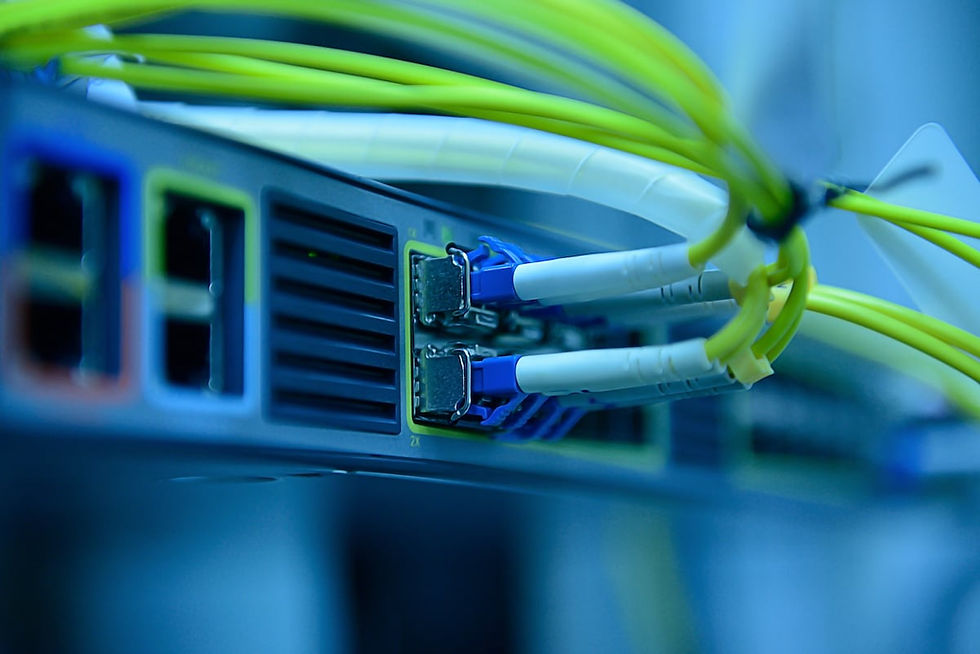What is FTTx? Network Design & Testing
- Analytics eseo
- May 8, 2024
- 4 min read
Updated: May 10, 2024

Fiber to the x (FTTX, also known as ‘fiber’) represents the overarching concept for any broadband network structure employing optical fiber for all or a portion of the local loop in telecommunications. Optical fiber outperforms copper in data transmission capacity, especially over long distances. In the 21st century copper wired telephone networks built around the existing 20th century analogue POTS (plain old telephone service) are being upgraded for efficiency reasons to use more efficient fiber. FTTX refers to several set-ups of different fiber optic cable types, using the FTTP/FTTH/FTTB (direct to premises/homes/buildings) and FTTC/N (fiber to cabinets/nodes, with copper wires to complete the connection) categorisation.
FTTX Configurations
Here's a breakdown of the most common FTTx configurations:
FTTP/FTTH/FTTB (Fiber to the Premises/Home/Building):
FTTP (Fiber to the Premises)
FTTP offers higher bandwidth and faster internet speeds from an internet exchange
Customization: FTTP is customizable, allowing customers to remotely change their services.
Reliability: FTTP is more reliable and secure than other internet services.
Affordability: FTTP offers a variety of services at affordable prices.
Resistance to electromagnetic radiation: FTTP is resistant to heat and electromagnetic radiation.
Involves fiber reaching the premises, typically offering speeds from 1 to 10 Gbit/s.
Utilizes passive optical networks and point-to-point Ethernet toward help triple-play services.
FTTH (Fiber to the Home)
Subsets of FTTP, referred to as fiber optic cables for individual residences.
It enables high-speed internet access for HD video streaming, online gaming, etc.
FTTH enhances the overall internet experience by ensuring stable consistent connectivity.
FTTB (Fiber to the Building)
FTTB involves connecting fiber optic cables to a multiple unit or commercial building.
This setup allows multiple tenants or businesses within the same building to benefit from high-speed internet connections.
FTTB is commonly used in apartment complexes, office buildings, and other shared spaces to deliver reliable and fast broadband services.
Connects fiber optics to an entire building, allowing multiple units to benefit from high-speed internet.
Provides versatility and high bandwidth, catering to multi-dwelling units and offering flexibility in deployment.
FTTC/N (Fiber To The Curb/Node):
Technology: It is the laying down of fiber optic cables to the curb or node closest to the end-user.
Purpose: It is to increase the speeds of internet and reliability to the end-users. FTTC/N and its Application Faster Connectivity: FTTC/N provides faster connections to the internet due to the utilization of fiber optic technology.
Network Efficiency: It is able to reduce signal interferences and provide a stable network to the users. Implementation: This technology is usually implemented by Telecom companies to improve its existing infrastructure and provide better services to its customers.

FTTx Technology Lifecycle
Network Design & Planning:
The FTTx technology life cycle starts with the planning stage whereby a well-coordinated design and planning process is critical for its successful implementation. Detailed considerations and initial planning are necessary before the establishment of the FTTx network design.
Deployment:
After the planning stage, the stage in which the physical implementation of the FTTx network architecture such as FTTH, FTTA, FTTB, or FTTC occurs is implemented. This stage requires the laying down of the optical fibers and connection to the network components.
Customer Connections and Installations:
During the installation stage of the FTTx technology lifecycle, customer connections are made, and installations are done so that end-users can access high-speed broadband services through the optical fiber network.
Monitoring & Maintenance:
Timely maintenance is essential for the proper functioning of the fiber optic communication network system. Appropriate monitoring practices and tools as instructed by fiber optic manufacturers are effective in monitoring network performance and addressing the maintenance needs in the timeliest manner. Routine monitoring and maintenance become essential for the reliability and efficiency of FTTx deployment.
Advantages of FTTX Over Traditional Copper Cable
Fiber to the "X" (FTTX) has various advantages over traditional copper cables, revolutionizing the way we access and connect with the internet in today's modern communication infrastructure:
Fiber optic cables can transmit data faster than copper cables.
They have higher transfer speed (bandwidth) capabilities than copper links, ready to help more information traffic.
They are resistant to short distances and are less susceptible to electrical interference because they conduct light rather than electrons.
FTTX networks have low power consumption.
These optic cables are difficult to tap because they lack metal conductors.
lighter and stronger than copper cables.
They are less likely to reflect, or stray, lighter than copper cables.
Easy and fast installation.
Low-cost maintenance.

Syrotech Networks: Efficient Fiber Network Management
We, at Syrotech Networks, are leading the way in the future of networking with our innovative solutions. As fiber optic manufacturers, our cutting-edge technology and reliable connectivity options empower networks to reach new heights. Stay connected and experience seamless integration with Syrotech Networks.
Our Range of Fiber Networking:
Optical Transceivers: Syrotech Optical Transceiver offers flexible connectivity solutions for high-speed data transfer in compact devices.
ONT (Optical Network Terminal): Syrotech ONT provides high-speed, low-latency internet via fiber optics, ensuring reliable connectivity for various devices and future technological demands.
OLT (Optical Line Terminal): Syrotech OLT offers efficient and cost-effective fiber network management for high-speed data transmission and versatile service provisioning in telecom and broadband networks.
Media Converters: Media Converters facilitate seamless data transmission between different network mediums, extending connectivity range and allowing integration of fiber-optic and copper-based systems for enhanced network flexibility and compatibility.
Wireless: Enables convenient wireless internet distribution at home, enhances wireless coverage and capacity in larger spaces, catering to diverse connectivity needs.
Get In Touch
Get in touch with Syrotech Networks, one of the leading fiber optic manufacturers. We empower networks with seamless connectivity solutions for high-speed data transfer and efficient network management.



Comments